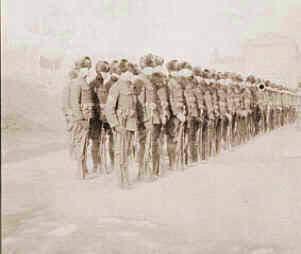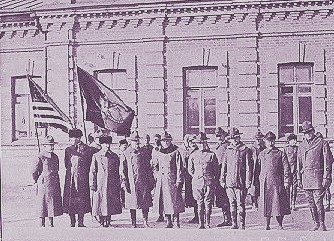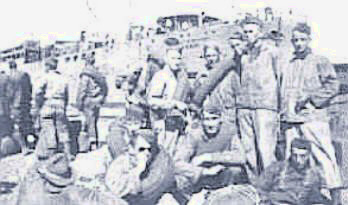The Story of the American Expeditionary Forces |
||||||
 Doughboys Marching Through Siberia It was a war few Americans knew about then or now. Orchestrated behind closed doors, inspired by panic, and plagued by futility, America's military intervention in Siberia during the First World War continued long after the Armistice sent the doughboys in France home. President Woodrow Wilson considered the order to send American troops to Siberia, a region besieged by civil war, lawlessness, and murder, one of the most difficult decisions of his presidency. Despite Russia's separate peace treaty with Germany ending the war on the Eastern Front early in 1918, Wilson hesitated to get involved in Russia's civil war even at the Allies insistence. By Summer 1918 things changed. The mounting Japanese occupation of Siberia threatened American business interests in the East. Piles of Allied military goods amassing to over 600,000 tons of war materials laid vulnerable around the crowded city.[1] The plight of the stranded Czech Legion vulnerable to the merciless Red Army gave Wilson a much needed moral foundation for intervention. Intervention, Wilson realized, could be used later to pressure the Allies into adopting his ideas for a League of Nations. Alone at his typewriter, Wilson outlined America's intentions in sending troops to Siberia in a seven-page document titled, "Aide Memoire." It was distributed to the Allies July 17, 1918.[2] Based on complete neutrality in Russian politics and territorial integrity, it contained more diplomatic hypotheses than decisive military strategies. It was the only directive given to the commander of America's military in Siberia.
The first American troops, 1,590 from the Twenty-Seventh Infantry Regiment, arrived in Vladivostok to a cheering crowd of White Russians on August 16, 1918 followed by 1,421 troops from the Thirty-First Infantry Regiment on August 21.[5] Under the temporary command of Colonel Henry D. Styer, they disembarked into a city buried in the depths of anarchy, collapse, and ruin. Streets were littered with debris. A rancid stench filled the air. Local leaders battled for control. Without orders, Styer and his men waited for Graves to arrive and wondered why they were in this godforsaken place. In the meantime, Colonel Styer agreed to send a regiment from the 27th Infantry to accompany a Japanese division on a reconnaissance operation along the Trans-Siberian Railway. The Japanese told Styer that 15,000 German and Austrian prisoners of war and Bolsheviks headquartered in the Ussuri Valley threatened Vladivostok.[6] Despite the frigid temperatures and difficult ground, the regiment marched over 1,000 miles in pursuit of the retreating Bolsheviks resulting in the capture of Blagoveschensk.[7] The Russians, impressed with American drive, nicknamed the 27th Infantry, the "Wolfhounds". Major General Graves arrived at Vladivostok on September 1, 1918 with 5,000 Eighth Division troops. Finding no threat to the city, he ordered the troops back to their garrison. Graves had hoped to avoid situations like the Ussuri Campaign, and interpreted from the Aide Memoire that U.S. troops were "not here to fight Russia or any group or faction in Russia."[8] A strict policy of neutrality was immediately announced to the troops. Bolsheviks and White Russians would be treated equally. By the time Graves arrived in Siberia, circumstances had changed. The Czech Legion no longer needed rescuing. The Japanese had 72,000 troops spread all over the region.[9] The search for German and Austria-Hungarian prisoners of war was unnecessary as they willingly turned themselves in preferring American rations and humane treatment to freedom. With little else do to, American troops patrolled and guarded the city. The Armistice in November 1918 ending the conflict in Europe gave Graves and most American soldiers in Siberia hopes of returning home. Instead, four American companies settled with the first snows of winter 300 miles south in Spasskoe.[10] While Congress questioned the intervention, Wilson found new excuses for the troops to stay.  In Formation in the SnowBy Spring 1919, the 27th Infantry found themselves divided between the Trans-Baikal region and Habarovsk on the Amur River; while detachments of the 31st Infantry were distributed along the railroad from Vladivostok to the Suchan Valley.[12] In March, the need to transport military supplies and maintain communications for the White Russians produced the Inter-Allied Railway Agreement which divided the 6,000 mile-long Trans-Siberian Railway into sectors.[13] Allied military detachments would protect their sectors from guerilla attacks and keep the railway and lines of communication open. Graves immediately issued orders to his troops: "Our aim is to be of real assistance to all Russians in protecting necessary traffic movements within the sectors on the railroad assigned to us...All will be equally benefited, and all will be treated alike by our forces..."[14] However, the railway was the main artery of White Russian forces and American detachments soon discovered that Russians along the Trans-Siberian Railway sympathized with the Bolsheviks. At the village of Sviyangino, Bolshevik Partisans frequently wrecked havoc with the tracks and telegraph poles. As one soldier noted, "Almost daily we had been called to repair destroyed stretches [of track]".[15] At Novitskaya, a Partisan ambush led to the deaths of five American soldiers.[16] Partisan duplicity disturbed most Americans. Locals who sold them milk and vegetables in the morning often tried to kill them at night. Click here to view related material from the National ArchivesAmerican soldiers also became the targets of Cossack terror. Colonel Styer informed Graves in February 1919: "[Kalmikov's] power of life and death has been so indiscriminately used as to create a reign of terror, and the life of no solider or civilian is safe."[18] At Posolskaya, Cossocks commanded by Semenov opened fire with machine guns from their armored train into a boxcar of sleeping doughboys. At Habarovsk, Kalmikov's men killed an American Signal Corpsman working on a telegraph pole.  AEF Siberia HeadquartersGraves had other difficult matters to attend. A miner's strike instigated by the Red Army in the Suchan Valley immobilized coal production needed by the railroad. The American detachment sent to the Suchan Mines had to restore stability without interfering between the Bolshevik miners and Anti-Bolshevik administration. Graves's refusal to arrest striking miners infuriated Anti-Bolsheviks who accused him of harboring Red sympathies. On May 23, 1919, Bolshevik leader Yakov Triapitsyn, who had assisted striking miners, threatened to murder every American soldier in the Suchan Valley unless they withdrew from the area.[21] Graves ordered that all Partisans be removed by force. In August, Captain B. H. Roads with a 40-man detachment did just that. Triapitsyn retreated from the valley, and the mines operated quietly from then on. Patrolling a sector near Romanovka , American soldiers from the 31st Infantry, now nicknamed the Polar Bears, faced certain death. At 4am on June 25, 1919 Partisans opened fire into their camp.[22] Using single shot rifles, the Partisans took advantage of the unguarded camp left vulnerable between sentries and surrounded it. According to Sergeant Joseph B. Longuevan bullets pierced into their tents causing "some of the cots to topple" and one solider "[was] hit 17 times."[23] In the panic, few soldiers grabbed rifles or ammo as they headed for cover in nearby log houses. Outnumbered 20 to 1, they faced an imminent slaughter.[24] Running low on ammo and seeing no reprieve, Corporal Brodnicki volunteered to go for help. Although seriously wounded, he found another American company. Four hours after the first gunshots, machine gun fire from Lieutenant Lorimer's platoon on the enemy's flank caused the Partisans to withdraw.[25] American casualties were heavy: 26 men died in the first minutes alone.[26] Among the dead Partisans, soldiers recognized a local man who regularly sold them milk. In Iman, just north of Vladivostok, Kalmikov's men kidnapped an American captain and corporal. The captain managed to escape, but the corporal remained. Major Charles A. Shamotulski arrived at Iman with 150 men from rifle and machine gun detachments for a showdown with the Cossacks.[27] While the Japanese threatened to side with the Cossacks in an attack, Shamotulski stood his ground and they backed off. Brutally beaten and tortured by his captors, the corporal was released days later. Graves suspected the Japanese had orchestrated the whole thing. American detachments along the railroad found themselves exposed to increasing harassment from Partisans and Cossacks. On September 12, 1919, American headquarters at Spasskoe received orders to use their entire force against any Cossack attacks.[28] By December, American soldiers were in grave danger of a massive assault. Graves cabled the War Department: "Safety of American troops demands concentration which results in abandoning parts of our sector."[29] The orders were approved. Winter of 1919-1920 brought more bad news. The White Russian Army was defeated at the Volga Front. The Siberian government collapsed. Congress demanded the complete withdrawal of American troops. Wilson realized the intervention was over.  Departing for HomeYears later, Secretary Baker confessed, "The expedition was nonsense from the beginning and always seemed to me one of those sideshows born of desperation."[32] An insufficient number of troops, political misconceptions, a lack of military strategy all contributed to the failed intervention. And yet, the war against Bolshevism had every opportunity for victory. Trotsky remarked at the time, "When the Allies manage to act unanimously and undertake a campaign against us, all shall be lost."[33] Coordinated effort, a clear purpose, and more troops had the chance to make history. It is to the men who died in the forgotten war in Siberia and served their country nobly when their brothers in France had long since returned home, that deserve respect and honor. The local Russians they protected, the harsh winters they endured, the atrocities they tried to stop, and the railroad they rebuilt time and time again defy all definitions of failure.  Graves of US Soldiers in SiberiaNotes:
CREDITS:Christine Putnam is an Honors Graduate in Communications from Cal State Northridge. Here interest in the Great War blossomed when she discovered her great-uncle had been killed in action in France during the First World War. Thanks to Herb Stickel, the 27th Regimental History Society and 8thinfdiv.com for the photos.
Michael E. Hanlon (medwardh@hotmail.com) regarding content, or toMike Iavarone (mikei01@execpc.com) regarding form and function. Original artwork & copy; © 1998-2000, The Great War Society |


